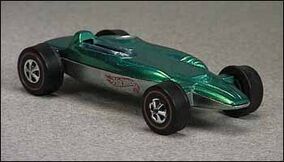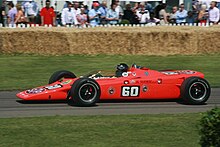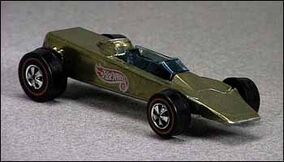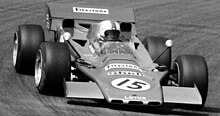I just noticed an ad for "pt6 nation" which I just happen to know is a small turboprop aircraft engine, one of the most popular in history. Under legacy, turns out this was the engine they tried out in 2 indy cars which I remember as Hot Wheels cars. They were very fast, almost too fast and could have won if they could have lasted all 500 miles. They weren't just turbine powered, they were also 4-wheel drive, a feature of rally cars today, and the door-stop styled Lotus 56 paved the way for today's wings - on - wedge cars that were to dominate by the mid 1970s until today. Turbines never made it in cars or trucks as practical, although eventually they ended up powering Navy ships and the M-1 Abrams tank, and was briefly tried out in trains.
STP-Paxton Turbocar
From Wikipedia, the free encyclopedia
 | |||||||||
| Category | USAC Roadster | ||||||||
|---|---|---|---|---|---|---|---|---|---|
| Constructor | Granatelli | ||||||||
| Designer(s) | Ken Wallis Andy Granatelli | ||||||||
| Technical specifications | |||||||||
| Chassis | Space frame | ||||||||
| Suspension (front) | Double wishbone with coil spring | ||||||||
| Suspension (rear) | Double wishbone with coil spring | ||||||||
| Engine | United Aircraft of Canada ST6B-62gas turbine, mid-mounted | ||||||||
| Transmission | 1-speed | ||||||||
| Tyres | Firestone | ||||||||
| Competition history | |||||||||
| Notable entrants | |||||||||
| Notable drivers | |||||||||
| Debut | 1967 Indianapolis 500 | ||||||||
| |||||||||
The STP-Paxton Turbocar was a racing car, designed by Ken Wallis as the STP entry in the Indianapolis 500.
Contents[hide] |
[edit]History
Wallis, a distant relative of famed British engineer Barnes Wallis, had developed a workable plan for harnessing a gas turbine to a race car. He first presented the idea to Dan Gurney, who passed on the idea. Wallis then offered the plan to Carroll Shelby and Shelby said (according to later court testimony), "Hogwash." Finally, Andy Granatelli of STP expressed interest in the concept. Wallis and his crew moved in with Andy's brother Joe at STP's Paxton division in Santa Monica, and they began work on the turbocar in January 1966. It was Granatelli who introduced a side-by-side concept—that is, putting the engine at the driver's left. Granatelli also added four-wheel drive to the design.[1]
The aluminum frame of the car was badly warped during heat treating in early 1966, eliminating any possibility of the car racing in the 1966 Indianapolis 500.[2] Work started over again and the car was ready for the 1967 Indianapolis 500. Parnelli Jones drove the car during tire testing in Phoenix early that year and was impressed with the car. He agreed to drive the car in the Indianapolis 500 after being offered $100,000 and half of any prize money he won.[3]
Jones qualified the car at Indianapolis in sixth place at 166.075 mph. At the start of the race, he quickly took the lead and rarely relinquished it. However, with just eight miles left to go, he coasted into the pits with a transmission bearing failure.[4] The car was refurbished and entered by STP in the 1968 Indianapolis 500. Driven by Joe Leonard, the car crashed into the wall during qualifying and never raced again.[1][5]
The car was originally donated to the Smithsonian Institution's National Museum of American History by the STP Corporation. It is currently on loan to the Indianapolis Motor Speedway Hall of Fame Museum.[6] The design was unique enough for Mattel to include a model of the car as the "Shelby Turbine" as one of the popular Hot Wheels toy cars. The Lotus 56 used a modified version of the same engine and 4 wheel drive in a more advanced wedge-shaped body with new USAC intake restrictions, but one car crashed and the 3 entered into the race did not finish either before USAC banned turbine and 4-wheel drive cars entirely.
[edit]Design
The STP-Paxton Turbocar was built around an aluminum box-shaped backbone. The driver was seated on the right side of the backbone, while the engine, a Pratt & Whitney Canada ST6B-62turbine engine, was mounted on the left side of the backbone. Though never successful as an automobile powerplant, the small aircraft engine it was based on would become one of the most popular turboprop aircraft engines in history. The engine drove a Ferguson 4-wheel drive system, which transmitted the power to the wheels. A torque converter eliminated the need for a clutch pedal and gearshift. The engine idled at 54% of full throttle, which meant that the driver didn't even have to press the accelerator pedal to pull away; all he had to do was ease his foot off the brake pedal. A movable panel was mounted behind the cockpit, which acted as an airbrake. The suspension's coil springs were located inside the backbone and the suspension A-frames had airfoil cross-sections. The car weighed 1,750 pounds, a few hundred pounds more than the Indy minimum weight of 1,350 pounds.[4]
USAC had limited the engine intake area to 23.999 square inches to limit the turbine's power output, but the engine still produced 550 hp. However, drivers reported that it had a three-second throttle lag. In less than a month after the 1967 Indianapolis 500, USAC cut the allowable turbine air intake area from 23.999 to 15.999 inches and imposed the ruling immediately, although it had been customary to give two years' notice of engine changes.[1] With the reduced inlet area, the maximum lap speed that could be achieved was 161 mph.[7]
Versions
Shelby Turbine
| |||||||||||
Shelby Turbine was a car from the 1969 Hot Wheels series.
Although superficially similar to the revolutionary STP 4WD gas-turbine racer which nearly won the 1967 Indianapolis 500, this is a completely different car, built by Carroll Shelby in preparation for the 1968 race but quietly withdrawn before the event and subsequently all but forgotten. Similarities with the more famous STP car include the oddly asymmetrical design, with the driver sitting to the right of the turbine engine.
Versions Edit
Edit
The Shelby Turbine has come out in the following versions:
Col #  | Year | Series  | Color  | Tampo  | Base Color / Type  | Window Color  | Interior Color  | Wheel Type  | Toy #  | Country | Notes | Photo  |
|---|---|---|---|---|---|---|---|---|---|---|---|---|
| 1969 | 1969Grand Prix Series | Spectraflame Green | One side has Hot Wheels logo, Optional stickers "69" and "Shelby" | Unpainted Metal | Light Blue | Black | RL | 6265 | Hong Kong |
[edit]
References
- ^ a b c 'I've Got the Car Right Here' Retrieved 27 June 2011
- ^ Granatelli, Andy, They Call Me Mister 500 Henry Regnery Company. January 1969. ISBN 0809296357
- ^ 'Parnelli Jones Made Mark in Speedway History' Retrieved 27 June 2011
- ^ a b 'The Big Engine That Almost Did' Popular Mechanics August 1967. Retrieved 27 June 2011
- ^ Autocourse Official History of the Indianapolis 500 Davidson, Donald and Shaffer, Rick . MBI Publishing Company, 2006. ISBN 1905334206.
- ^ Indianapolis Motor Speedway Museum Retrieved 27 June 2011
- ^ 'Roger Ward's Indy 500 Preview: Will the Turbines Take Over?' Popular Mechanics May 1968.
[edit]
Lotus 56
From Wikipedia, the free encyclopedia
The Lotus 56 was a racing car, designed by Maurice Philippe as Team Lotus' 1968 entry in the Indianapolis 500, replacing the successful Lotus 38.
Contents
[hide]
[edit]Indy 500
The Lotus 56 used a modified version of the ST6 gas turbine used on the STP-Paxton Turbocar("Silent Sam") that almost won in 1967. The ST6 was based on a small aircraft engine that would become one of the most popular turboprop aircraft engines in history. But the car itself was an entirely new and more advanced design which introduced a distinctive aerodynamic wedge-shaped body rather than a cigar-shape, just a few years before the introduction of front and rear wings. [1]. USAC, the governing body of the Indy 500, had implemented new rules aimed at handicapping turbine powered racing cars by drastically reducing the air intake size. Te Lotus 56 made up for reduced power with a sophisticated suspension design, retaining the 4wd concept of the Silent Sam, but with lighter weight, and advanced aerodynamics.
Lotus had suffered the death of Lotus' ace driver Jim Clark in a Formula 2 race in Germany. Mike Spence was killed at Indianapolis in one of 4 56's built while testing it. The remaining 3 cars withGraham Hill, Joe Leonard, and Art Pollard were entered for the race, with Leonard claiming pole position. Unlike the year before, when the STP-Paxton Turbocar easily outperformed the other cars in the race, in the race the turbine cars were relatively evenly matched with the other top contenders, much of which must be attributed to aerodynamics and the 4wd chassis design and not the turbine engine. Hill's car crashed, Pollard's car broke down, while Leonard was leading with just a handful of laps to go when the a fuel pump shaft failed. Shortly thereafter, the USAC imposed additional restrictions on turbine cars that essentially removed them from competition. For the second year in a row STP turbine cars had brought innovation to the Indy 500 and had failed to win while leading within a few laps of the end of the race. USAC subsequently banned turbine cars and for wheels drive completely, but it was unusual enough that Mattel produced as model as the "Lotus Turbine" as one of the popular mass-produced die cast Hot Wheels cars.
Lotus Turbine
Lotus Turbine Debut Series Grand Prix Produced 1969 Designer Ira Gilford Number 6262
Lotus Turbine was a car from the 1969 Hot Wheels series. It is a model of the innovative wedge-shaped 1968 Lotus 56 which was not only powered by an industrial gas turbine but was also four-wheel drive. In the 1968 Indianapolis 500 the car initially performed well but eventually suffered fuel pump problems, two out of three cars retiring during the race and the third, driven by Graham Hill, crashing early on. A fourth Lotus 56 had crashed during test sessions, killing its driver, Mike Spence. After the 1968 season, USAC rules were changed to ban both turbine engines and four-wheel drive.
In 1971 the Lotus 56 was raced in Formula 1 on occasion by Team Lotus but the large fuel tanks required to allow it to run an entire race without refueling left it overweight and uncompetitive.
The Lotus 56, while never winning a race, demonstrated the importance of aerodynamics in racing cars, along with Jim Hall's Chaparrals, and effectively set the mold for open wheeled racing cars for the next ten years. Chapman's Lotus 72 employed the same wedge nose shape and went on to win three world championships in Formula 1.
[edit]Formula One
Colin Chapman developed the 56 as a potential F1 contender, part of his plan to have a single design to compete at both the Indy 500 and in Formula 1, but it was too heavy and never competitive. The car was designated as the 56B and Emerson Fittipaldi tried it in the 1971 Race of Champions and International Trophynon-Championship meetings. At Brands Hatch, during wet practice, the 56 was far and away the fastest car on the track, but the race was held in dry weather and the car was lost in midfield. At the Silverstone-based International Trophy, the car only lasted three laps of the first heat before suspension failure forced Fittipaldi's retirement. Dave Walker ran the car in the Dutch Grand Prix, and had progressed from 22nd to 10th in five laps of the very wet track, before sliding off the road and into retirement. Fittipaldi used the car again in that year's 1971 Italian Grand Prix and managed to bring the fragile design home 8th.
[edit]Formula One World Championship results
(key)
Year Entrant Engine Tyres Driver 1 2 3 4 5 6 7 8 9 10 11 WCC Pts. 1971 Team Lotus Pratt & Whitneyturbine F RSA ESP MON NED FRA GBR GER AUT ITA CAN USA 21* 5th Emerson Fittipaldi 8 Reine Wisell NC Dave Walker Ret
* No points with the Lotus 56B
[edit]Notes
[edit]
Lotus 56
From Wikipedia, the free encyclopedia
The Lotus 56 was a racing car, designed by Maurice Philippe as Team Lotus' 1968 entry in the Indianapolis 500, replacing the successful Lotus 38.
Contents[hide] |
[edit]Indy 500
The Lotus 56 used a modified version of the ST6 gas turbine used on the STP-Paxton Turbocar("Silent Sam") that almost won in 1967. The ST6 was based on a small aircraft engine that would become one of the most popular turboprop aircraft engines in history. But the car itself was an entirely new and more advanced design which introduced a distinctive aerodynamic wedge-shaped body rather than a cigar-shape, just a few years before the introduction of front and rear wings. [1]. USAC, the governing body of the Indy 500, had implemented new rules aimed at handicapping turbine powered racing cars by drastically reducing the air intake size. Te Lotus 56 made up for reduced power with a sophisticated suspension design, retaining the 4wd concept of the Silent Sam, but with lighter weight, and advanced aerodynamics.
Lotus had suffered the death of Lotus' ace driver Jim Clark in a Formula 2 race in Germany. Mike Spence was killed at Indianapolis in one of 4 56's built while testing it. The remaining 3 cars withGraham Hill, Joe Leonard, and Art Pollard were entered for the race, with Leonard claiming pole position. Unlike the year before, when the STP-Paxton Turbocar easily outperformed the other cars in the race, in the race the turbine cars were relatively evenly matched with the other top contenders, much of which must be attributed to aerodynamics and the 4wd chassis design and not the turbine engine. Hill's car crashed, Pollard's car broke down, while Leonard was leading with just a handful of laps to go when the a fuel pump shaft failed. Shortly thereafter, the USAC imposed additional restrictions on turbine cars that essentially removed them from competition. For the second year in a row STP turbine cars had brought innovation to the Indy 500 and had failed to win while leading within a few laps of the end of the race. USAC subsequently banned turbine cars and for wheels drive completely, but it was unusual enough that Mattel produced as model as the "Lotus Turbine" as one of the popular mass-produced die cast Hot Wheels cars.
Lotus Turbine
Lotus Turbine Debut Series Grand Prix Produced 1969 Designer Ira Gilford Number 6262
Lotus Turbine was a car from the 1969 Hot Wheels series. It is a model of the innovative wedge-shaped 1968 Lotus 56 which was not only powered by an industrial gas turbine but was also four-wheel drive. In the 1968 Indianapolis 500 the car initially performed well but eventually suffered fuel pump problems, two out of three cars retiring during the race and the third, driven by Graham Hill, crashing early on. A fourth Lotus 56 had crashed during test sessions, killing its driver, Mike Spence. After the 1968 season, USAC rules were changed to ban both turbine engines and four-wheel drive.
Lotus Turbine
| |||||||||||
Lotus Turbine was a car from the 1969 Hot Wheels series. It is a model of the innovative wedge-shaped 1968 Lotus 56 which was not only powered by an industrial gas turbine but was also four-wheel drive. In the 1968 Indianapolis 500 the car initially performed well but eventually suffered fuel pump problems, two out of three cars retiring during the race and the third, driven by Graham Hill, crashing early on. A fourth Lotus 56 had crashed during test sessions, killing its driver, Mike Spence. After the 1968 season, USAC rules were changed to ban both turbine engines and four-wheel drive.
In 1971 the Lotus 56 was raced in Formula 1 on occasion by Team Lotus but the large fuel tanks required to allow it to run an entire race without refueling left it overweight and uncompetitive.
The Lotus 56, while never winning a race, demonstrated the importance of aerodynamics in racing cars, along with Jim Hall's Chaparrals, and effectively set the mold for open wheeled racing cars for the next ten years. Chapman's Lotus 72 employed the same wedge nose shape and went on to win three world championships in Formula 1.
[edit]Formula One
Colin Chapman developed the 56 as a potential F1 contender, part of his plan to have a single design to compete at both the Indy 500 and in Formula 1, but it was too heavy and never competitive. The car was designated as the 56B and Emerson Fittipaldi tried it in the 1971 Race of Champions and International Trophynon-Championship meetings. At Brands Hatch, during wet practice, the 56 was far and away the fastest car on the track, but the race was held in dry weather and the car was lost in midfield. At the Silverstone-based International Trophy, the car only lasted three laps of the first heat before suspension failure forced Fittipaldi's retirement. Dave Walker ran the car in the Dutch Grand Prix, and had progressed from 22nd to 10th in five laps of the very wet track, before sliding off the road and into retirement. Fittipaldi used the car again in that year's 1971 Italian Grand Prix and managed to bring the fragile design home 8th.
[edit]Formula One World Championship results
(key)
| Year | Entrant | Engine | Tyres | Driver | 1 | 2 | 3 | 4 | 5 | 6 | 7 | 8 | 9 | 10 | 11 | WCC | Pts. |
|---|---|---|---|---|---|---|---|---|---|---|---|---|---|---|---|---|---|
| 1971 | Team Lotus | Pratt & Whitneyturbine | F | RSA | ESP | MON | NED | FRA | GBR | GER | AUT | ITA | CAN | USA | 21* | 5th | |
| Emerson Fittipaldi | 8 | ||||||||||||||||
| Reine Wisell | NC | ||||||||||||||||
| Dave Walker | Ret |
* No points with the Lotus 56B




No comments:
Post a Comment